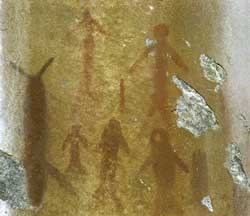
The rugged topography of the North Cascades separates two regions that contained large Native populations: the peoples of the Columbia River Basin to the east and those of the Pacific Northwest/Puget Lowlands to the west. A trade network connected and enabled them to share locally abundant resources for any materials they lacked. They traveled across mountain passes to trade. They followed ridge crests to avoid dense brush along avalanche shoots and stream bottoms.
The difficulty of travel across these rugged mountains made intimate knowledge of them extremely important. Routes to the major mountain passes were vital to indigenous peoples. Lake Chelan and Upper Skagit groups used Cascade Pass regularly as a trade route through the mountains. They called the pass Stehekin, "the way through." The Upper Skagit people reportedly cached canoes at the head of Lake Chelan to use in their trips southward down the lake. The mountains were inhabited mainly in summer and fall, when milder weather and melting snows permitted access into the high country. But reports exist that Upper Skagit might have traversed Cascade Pass in winter en route to Lake Chelan. When traveling to the east, the Chelan people crossed by way of Twisp Pass. Recent archaeological evidence indicates that Whatcom Pass might have been used by the Chilliwack and Lower Thompson Natives as a trade route across the northern end of the range.
(Adapted from "Sharing the Skagit: An Educator's Guide to the Skagit River Watershed" from the North Cascades Institute. © 1993.)
|
Last updated: October 22, 2017
